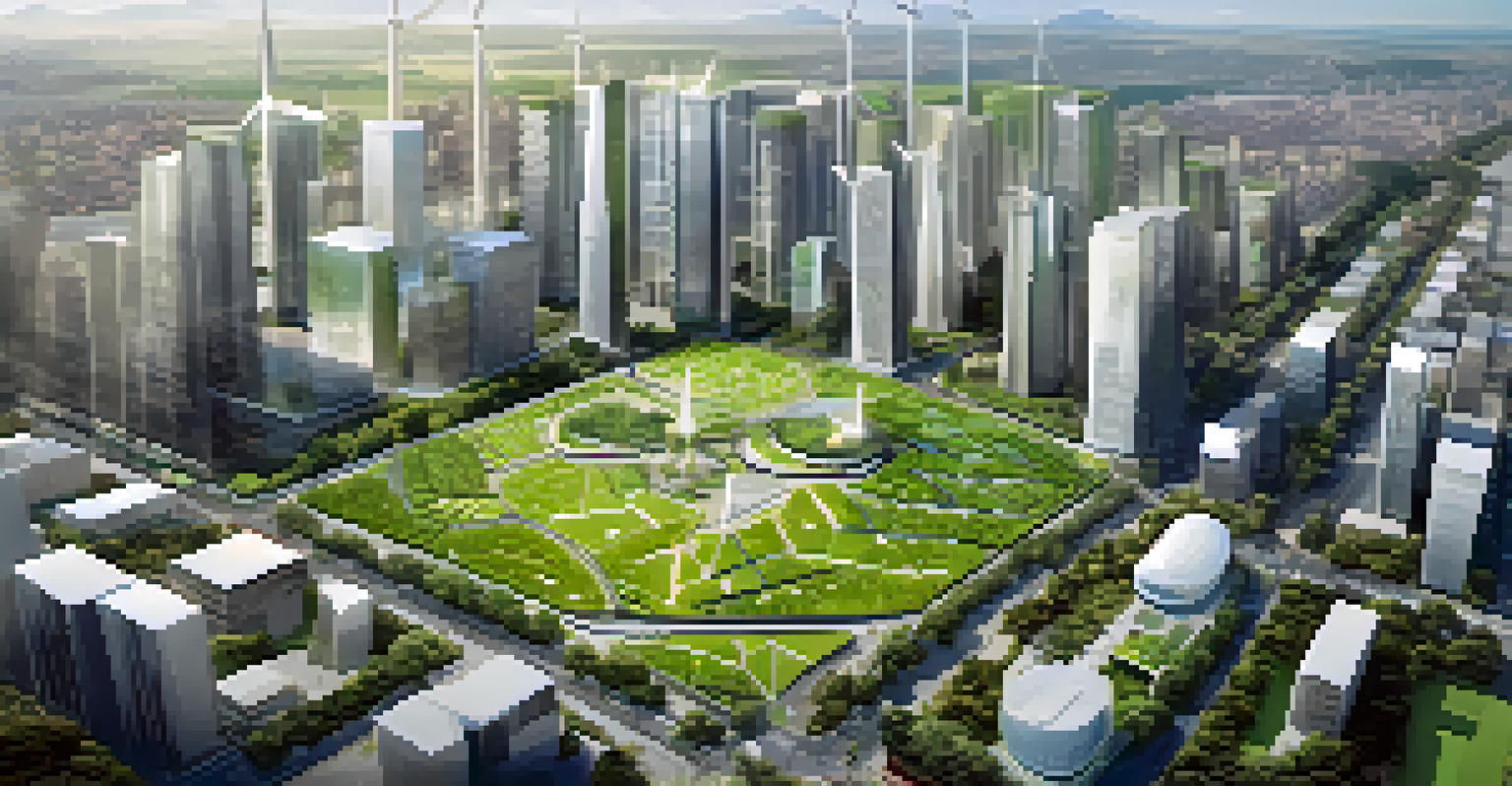How Smart Cities are Shaping Tomorrow's Urban Environments

Understanding Smart Cities and Their Importance
Smart cities leverage technology and data to improve urban life and sustainability. By integrating IoT devices, cities can monitor traffic, manage energy use, and enhance public safety. This concept is not just about technology; it’s about creating a better quality of life for residents.
The city is not a mere collection of buildings, but a living organism that needs to be nurtured and enhanced with technology for a better tomorrow.
The importance of smart cities has grown as urban populations expand. With more people flocking to cities, traditional infrastructure struggles to keep up. Smart solutions offer innovative ways to manage resources effectively, aiming to create harmonious living spaces.
Ultimately, smart cities are designed to address pressing urban challenges, such as pollution, congestion, and waste management. These efforts lead to healthier environments, happier residents, and more efficient governance.
Key Technologies Driving Smart City Innovations
At the heart of smart cities are various technologies that enhance urban living. Internet of Things (IoT) devices, for instance, collect data from sensors that monitor everything from air quality to public transportation. This data helps city planners make informed decisions.

Another critical technology is artificial intelligence (AI), which analyzes vast amounts of data to identify patterns and predict future trends. Imagine traffic lights that adjust their timings based on real-time traffic flow, reducing congestion and improving travel times.
Smart Cities Enhance Urban Life
By leveraging technology and data, smart cities aim to improve quality of life, sustainability, and resource management.
These technologies work together to create a seamless urban experience, where residents can enjoy more efficient services. With the right tools in place, cities can respond faster to emergencies and adapt to the needs of their citizens.
Enhancing Transportation Through Smart Solutions
Transportation is one of the most significant areas where smart city initiatives make an impact. Smart traffic management systems can optimize traffic flow, reducing travel time and emissions. Think of it like having a personal traffic guide that always knows the best route.
Technology is best when it brings people together and makes their lives easier and more enjoyable.
Moreover, smart public transport systems use real-time data to inform commuters about delays or changes. This transparency encourages more people to use public transport, leading to less pollution and fewer cars on the road.
As cities adopt electric and autonomous vehicles, the landscape of urban transportation is changing. These innovations not only promise efficiency but also create a safer, cleaner environment for everyone.
Boosting Sustainability in Urban Environments
Sustainability is at the core of smart city initiatives, focusing on reducing waste and conserving resources. Smart waste management systems, for example, use sensors to monitor trash levels and optimize collection routes. This means fewer trucks on the road and less fuel consumption.
Renewable energy sources, such as solar panels and wind turbines, are increasingly integrated into urban planning. Cities can harness these resources to power homes and businesses, creating a greener energy landscape.
Key Technologies Drive Innovation
Innovative technologies like IoT and AI play a crucial role in optimizing urban services, enhancing transportation, and boosting public safety.
By prioritizing sustainability, smart cities not only contribute to environmental health but also improve the quality of life for residents. Cleaner air, greener spaces, and efficient resource management are just a few benefits of this approach.
Improving Public Safety with Smart Technologies
Public safety is a crucial concern in urban areas, and smart cities offer innovative solutions to enhance security. Surveillance cameras equipped with AI can identify suspicious activities, allowing law enforcement to respond quickly. It's like having an extra set of eyes on the streets.
Additionally, smart emergency response systems can analyze real-time data to deploy resources more effectively during crises. Imagine a system that automatically reroutes ambulances based on traffic patterns, getting help to those in need faster.
These technologies create safer environments, fostering a sense of community and trust between residents and local authorities. With enhanced safety measures, people feel more at ease in their neighborhoods.
Fostering Community Engagement and Inclusivity
Smart cities aim to involve residents in decision-making processes, fostering a sense of community. Digital platforms allow citizens to provide feedback on urban projects, engage in discussions, and participate in local governance. This participatory approach empowers individuals and strengthens community bonds.
Moreover, smart city initiatives focus on inclusivity by addressing the needs of diverse populations. Accessible technology ensures that everyone, including those with disabilities, can benefit from urban innovations.
Community Engagement is Essential
Fostering community participation and inclusivity ensures that smart city initiatives address the diverse needs of all residents.
By prioritizing community engagement, smart cities create environments where residents feel valued and connected. This sense of belonging enhances overall well-being and encourages civic participation.
Challenges and Considerations in Smart City Development
While the benefits of smart cities are promising, challenges remain. Issues such as data privacy, cybersecurity, and infrastructure costs must be addressed to ensure successful implementation. It's crucial to strike a balance between innovation and safeguarding residents' privacy.
Additionally, the digital divide can hinder the equitable distribution of smart city benefits. If access to technology is limited, some communities may be left behind, exacerbating existing inequalities.

To overcome these challenges, collaboration between governments, businesses, and communities is essential. With a united effort, cities can navigate obstacles and pave the way for inclusive, sustainable urban growth.